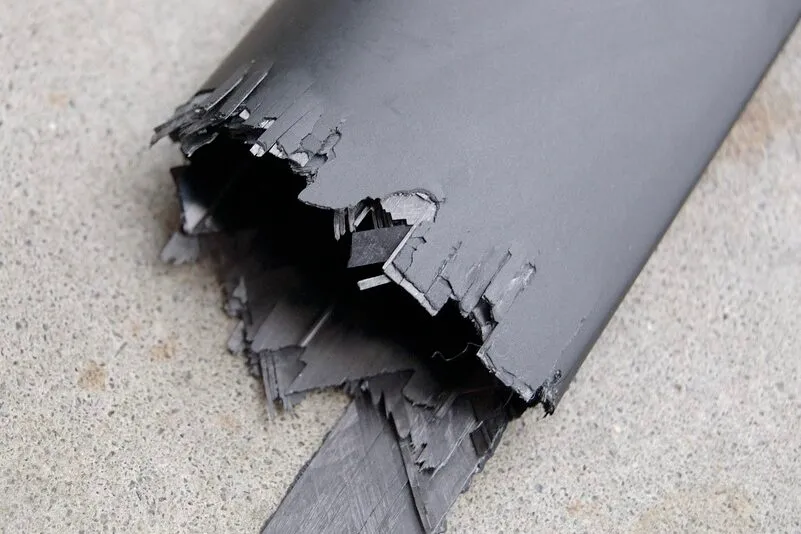Much is made about the environmental benefits of cycling. Bicycles are almost universally touted as being “good” for the environment, because riding a bike is green due to their small—if any—carbon footprint when compared to automobiles. But—even disregarding their environmentally costly production—what about the carbon fiber footprint that is left when a carbon bike ends up in a landfill?
The fact is it will be there for a very long time.
Carbon fiber is neither biodegradable nor photodegradable. It's a composite material, which means that it's a combination of materials, whereby the different materials remain chemically separate and distinct within the finished structure. And as manufacturers have told us: it's all about layers of material. The precisely engineered layers are what give a carbon frame superior performance, but those many layers also make it a bear to recycle
Use of carbon, as a bike frame material is fairly new at least considering that steel had been used for more than 100 years to build bicycles. American manufacturer Craig Calfee was among the first to build a carbon bike, but the Italian manufacturer, Colnago, can be credited introducing carbon to the European pro ranks. Colnago partnered with Ferrari in the 1980s to build bikes from the, then, space age composite technology, which Ferrari exploited on the automotive racetrack.
The C35, a Colnago-Ferrari collaborative project, arrived in 1989 and went on to claim victories in the sport's highest profile events. By the mid-1990s several companies including early carbon pioneer Kestrel, as well as Trek were producing full carbon fiber frames. And today, just about every brand builds a large percentage of their bicycle line from carbon.
With all of these carbon frames out there many are likely to end up in landfills simply because their is no clear path to recycle the materials, but change may be coming as both Trek and Specialized announced carbon recycling initiatives— just this year.
Recycling carbon: first, find a use
Trek recently began a partnership with Materials Innovations Technology, an advanced materials company, which has developed ways of using reclaimed and scrap carbon fibers.
“We are taking Trek scrap and we wanted to close the loop,” Jim Stike, president of Materials Innovations Technology told BikeRadar. “We can create components and other ancillary items for the industry from this reclaimed material. We can take the used material and turn it in something for the bike industry. The beauty of carbon fiber is that you can reclaim it again and again.”
The problem however is the reclaimed material can only result in those smaller products, such as brake housings and water bottle cages. Those products may not even be more affordable than those made of other materials however.
Trek and MIT (Massachusetts Institute of Technology) see this as a good step in keeping the carbon fiber out of landfills, and MIT, which has worked with Boeing and Airbus, sees this as a step in the right direction.
“We’re coming up with solutions,” added Stike. “In Europe and Japan composites are not allowed in landfills, and that time is coming in America too. It has to come.”
Trek is not alone in the search for a solution. Specialized Bicycles have also begun their own recycling program, and this year hired back Bryant Bainbridge from Nike. He is now the company’s full-time sustainability strategist and says that carbon fiber recycling doesn’t really require new thinking in terms of the principles of recycling, but it does require a real push to build the infrastructure.
“In fact, at the moment there are only two facilities globally that recycle carbon fiber and both of those are essentially in start-up mode,” Bainbridge told BikeRadar. “That creates layers of challenges in both economies of scale and the simple act getting the material to a place where it can be reclaimed. While the majority of the carbon footprint is in creating carbon fiber, we prefer not to be shipping it long distances for material recovery. The good news is that there is market value in the material once it has been recycled and that demand really helps underwrite this effort. This is not like plastic bags where the value of the recycled material is often less than the cost of recovery.”

Unfortunately there is not a clear channel for reclaiming broken carbon components and frames
The tenets of recycling remain: less waste and less energy needed when re-using
One important tenant of recycling—of many materials, not just metals—is the amount of energy that recycling saves versus producing a product from virgin materials. Recycled soda pop cans made of aluminum for example only use five percent of the energy that it would take to produce a can from virgin aluminum. Thus a market is created whereby it is more cost effective to recycle, and this is why there are deposits on cans in many states as a way of encouraging the recycling. The question is whether bicycle frames made of carbon fiber would offer the same cost benefits to the manufacturers.
Whether returned bike frames result in a discount at the time of a purchase of a new bike is still likely years away, there is the issue of energy savings. Bainbridge maintains that the benefits are there. “In terms of energy cost, the facility we are working with claims the production of recycled carbon has a 95 percent reduction in energy over virgin carbon,” he said. “We haven't seen the studies to support this but when you consider the massive energy dump required to oxidize and carbonize virgin material this number makes sense. So there will be a real energy savings in reclaiming carbon fiber.”
The bicycle industry can’t do this alone either.
“While Giant doesn’t have a global program for consumers to recycle their bikes, we have a relationship with our supplier at Toray in Japan, one of the world’s largest producers of carbon-fiber,” said Andrew Juskaitis of Giant Bicycles, the world’s largest manufacturer of carbon fiber frames. “And they are working on building a carbon recycling solution. Our goal is to take back items that have been retired and to see that material reused and put into recycle products.”
The big worry right now is that carbon fiber bicycle frames are falling in price, and coming down market increasing the numbers significantly. Additionally, carbon fiber has been used with many high-end and so-called elite level bicycles in excess of 20 years, meaning that those bikes are coming to their respective end of life.
While scrap metal collectors in most parts of America would likely swoop down on an old steel bike left out on the curb, there is no comparable market for carbon fiber frames. This remains is a concern to Jim Colegrove, Senior Composite Engineer for Trek Bicycles. “In the not too distant future we are going to see more and more products sitting out on the curb," he said. "There exists the possibility of having some methodology that these frames don’t go in the landfill.”
Not only a 'bike' problem: aerospace and automotive industries' face the same issue
The bicycle industry isn't taking this problem on alone. In addition to looking at the automotive sector, which helped Colnago bring carbon fiber over from F1 racecars, the aerospace industry is currently the leading consumer of carbon fiber composite material. “The amount of composite material in one Dreamliner [long haul commercial jetliner] is more than year’s worth of bikes,” says Juskaitis. “Aerospace is exponentially larger than the whole sporting goods industry. That’s far more than all the bikes, golf clubs, canoes and tennis rackets that made of carbon fiber.”

The auto industry is dealing with the same problem as carbon creeps into mainstream production
With the real material stream for carbon fiber coming from the aircraft industry it's no surprise that Seattle, WA is at the forefront of the problem. “They want to be near Boeing,” says Bainbridge in regards to potential recycling partners. “But as the quest for more fuel efficient cars continues, carbon fiber is likely to be the material of choice in reducing weight and it is this use that will put carbon fiber in every part of the country. There is a lot of work at the moment to reduce the cost of carbon fiber through the use of some new precursors, such as lignin, which will greatly reduce costs and fuel this breakthrough.”
The biggest drawbacks say the manufacturers, is that currently there hasn’t been a complete solution that is reasonable and attractive to everyone. The bicycle industry is known as environmentally conscious, and it's encouraging to see the major producers are already starting to address the problem.
As the industry begins the process, the consensus is that everyone is headed in the right direction. Already several companies in multiple industries are looking at this before it actually becomes a problem. “I am cautiously optimistic that we are going to be able to break through this period of getting started,” says Colegrave.

